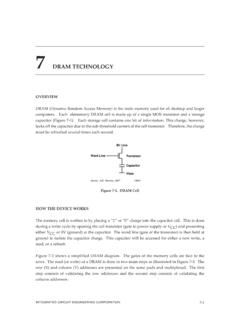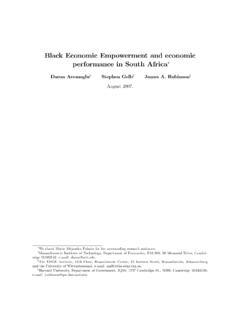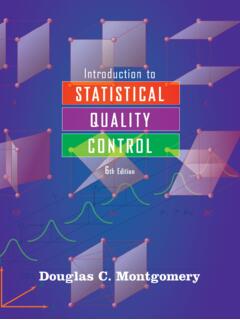Transcription of Changing Wafer Size and the Move to 300mm
1 77 Changing Wafer size and the move to 300mmAs discussed in Chapter 1, the industry sability to increase productivity by 25-30 per-cent per year is the combined result of wafersize transitions, shrinking device geometries,equipment productivity improvements, andincremental yield improvements. Wafer sizetransitions historically account for 4 percentof the 25-30 percent productivity make Wafer size transitionsbecause of the overall cost benefits resultingfrom the larger number of dice per Wafer ,thereby using the same number of processsteps to produce more dice. Based on histor-ical trends, peak demand for 200mm waferswill be reached around 2003, as shown inFigure 7-1. In addition, this SEMATECH study[1]indicates that each Wafer sizeremains in production for approximately 24years allowing companies sufficient time torecoup investments in the lifecycle perspective can be used as aguide as the industry makes transitions tolarger wafers.
2 By the year 2000, the first pro-cessing on 300mm (12 inch) wafers is antici-pated. 300mm wafers will accommodateroughly twice as many dice per Wafer as200mm wafers. Driving forces for all wafersize transitions include the factors of ever-increasing die size and increasing numbersof integrated functions per chip. Less obvi-ous, yet no less important factors such asincreasing global competition, 200mminstalled base and market conditions areinfluencing the rapidity with which 300mmsilicon wafers will become manufacturing-worthy and cost effective. Today, while man-ufacturers in the silicon world are making150 to 200mm transitions and evaluating300mm processing, many GaAs manufactur-ers are undergoing or considering transitionsto 150mm processing from 100mm.
3 The rela-tive Wafer sizes are shown in Figure to a New Wafer SizeWafer size increases can also be viewed interms of percentage increase in Wafer area, asshown in Figure 7-3. Interestingly, the movefrom 100mm (4 inch) wafers to 150mm (6inch) wafers increased the silicon area by 125percent the same relative gain that will berealized when semiconductor companiesmake the transition from today s 200mm (8inch) wafers to 300mm (12 inch). Beyond300mm, the same gain requires a jump to450mm wafers. Trends indicate that wafersize transitions industry-wide have typicallyenabled a 4 percent per year productivityimprovement, and the transition to 300mmshould provide between 2 and 4 percent peryear lower IC cost/cm2.
4 [1]INTEGRATED CIRCUIT ENGINEERING CORPORATION7-17 Changing Wafer size and the move to 300mmChanging Wafer size and the move to 300mmINTEGRATED CIRCUITENGINEERING CORPORATION7-2 Figure 7-4 illustrates the number of dice perwafer based on Wafer size and die size , whileFigure 7-5 can be used for more precise cal-culation of the maximum number of dice perwafer. Unfortunately, due to equipment pro- ductivity and price increases for larger waferprocessing tools, the cost savings resultingfrom Wafer size transitions may not scalewith these die per Wafer calculations. Forinstance, 200mm wafers offer nearly twicethe area of 150mm wafers ( ), but manyearly adopters of 200mm technology arguethat this transition did not result in twice asmany chips produced for the same manufac-turing costs.
5 In fact, if the cost of owning andoperating 200mm equipment is twice as highas the 150mm equipment, then the manufac-turing cost (per square centimeter of silicon)is the same. In this case, the cost savings onlyresults from the need for less than twice asmany pieces of equipment to process thelarger wafers. For these reasons, the questionof whether or not a fab can cost-effectivelymake Wafer size transitions depends greatlyon the utilization and efficiency of the waferprocessing Demand/Year (106 )Year'60 '65'70'75'80'85 '90'95'00'05 '10'15'20 '25100,00010,0001,0001001010 Source: VLSI Research, SEMATECH, I300I226241997 IronmanPilot LineTotal Wafer Area Trend Model1976-2025: 10% CAGR100%33%10%38/51mm75/100mm125/150mm20 0mm300mm450mmFigure 7-1.
6 Lifecycles of Different Wafer SizesChanging Wafer size and the move to 300mmINTEGRATED CIRCUITENGINEERING CORPORATION7-3 Evaluating the Cost Benefits of 150 to200mm TransitionsIn making Wafer size transitions, generallyspeaking, only a percentage of tools can beused to process subsequent Wafer enough, many fabs and equip-ment manufacturers anticipated makingsmall modification to equipment whenmaking transitions from 100mm to 125mmor 125mm to 150mm Wafer processing. Inreality, only 40-50 percent of the systemswere transferable; equipment needed to beredesigned, and usually new equipment setswere needed. When making transitions from150mm to 200mm Wafer processing, only ahandful of systems can be used on both is anticipated that none of the 200mm pro-cessing systems will be used to processupcoming 300mm wafers.
7 As users might expect, transitions in wafersize require complete evaluations of costfactor differences for each different processtool in the fab. Asimplified cost-of-owner-ship (COO) study of 150mm versus 200mmwet benches performed by Intel[2]revealedthat the top four contributors to COO are sig-nificantly different for 200mm and 150mmwet cleaning equipment (Figure 7-6).Deionized (DI) water costs, capital costs, con-sumable costs and facilities costs dominated200mm benches while capital, facilities, mon-itor Wafer , and DI water costs dominated for150mm systems. Most significantly, DI water,in going from 150 to 200mm Wafer process-ing, jumps from being the fourth highest costfactor to the first.
8 This difference is primarilydue to the tripling of flow rates needed toachieve equivalent rinsing of the 200mmbatch. Interestingly, while the test Wafer costrose from $35 to $135, its impact on COO less-ened because the monitoring frequencystayed constant between the two Wafer sizes. 22664 Source: ICE100mm125mm150mm200mm300mmFigure 7-2. Relative Difference in Wafer SizesChanging Wafer size and the move to 300mmINTEGRATED CIRCUITENGINEERING CORPORATION7-4050100150200 12556781257815612556 Wafer Diameter Transition100mm 125mm100mm 150mm125mm 200mm150mm 200mm200mm 250mmPercent IncreaseSource: ICE18603A250mm 300mm200mm 300mm300mm 400mm300mm 450mm44 Figure 7-3. Wafer Area Increases (Percent)20191 Source: ICEDice Per WaferDie size (mm2)10,0001,000100101102004006008001,00 01,2001,400300 mm200 mm150 mm125 mm100 mmFigure 7-4.
9 Dice Per Wafer Based on Die size and Wafer SizeChanging Wafer size and the move to 300mmINTEGRATED CIRCUITENGINEERING CORPORATION7-5 DIE AREAmil x1, , , size **AREA524444403232323232242424242416 1616161612121212121212121212121212444444 444444444444444444444444444444 9688807676686052525252524444403232323232 3232242424242424241616161616161612121212 12121212121212121212121212444444 4444444444441561481401201201121129696888 0807676686860525252525252444440403232323 2323232322424242424242424241616161616161 6161612121212121212121212121212121212121 2240224208192188164156148148140120120112 1121049696888880767676686868605252525252 5252444444404032323232323232323232242424 24242424242424241616161616161616161612 CANDIDATE NUMBER OF WHOLE DICE448424392376340332308292268256248240 2162082081881881801641561481481481321201 2012011211211210496968888888080767676686 8686860605252525252525252524444444440404 03232323232323232 Corner of die at center of full radius band around edge of Wafer not after die separation, 3 mil saw kerf.
10 **22673 Source: ICE300mm1,0601,0129368808207807326886566 1660055654050849246044043239239237635634 0332316308292284268256256248240224216208 2082001881881801801641641561561481481481 4813213212012012012011211211211211210496 9696888888888080 Figure 7-5. Die size Versus Die Count* Changing Wafer size and the move to 300mmINTEGRATED CIRCUITENGINEERING CORPORATION7-6 Studies like this and others can be used totarget key areas for cost reduction in 200mmfabs. In this example, the authors cited possi-ble reductions in bath volume through cassetteor cassette-less processing (which would bringDI water and consumables costs down), or theuse of hot DI water or sonic energy rinses toreduce rinse times. Operating costs can bereduced by optimizing the system for higherthroughput and utilization.






